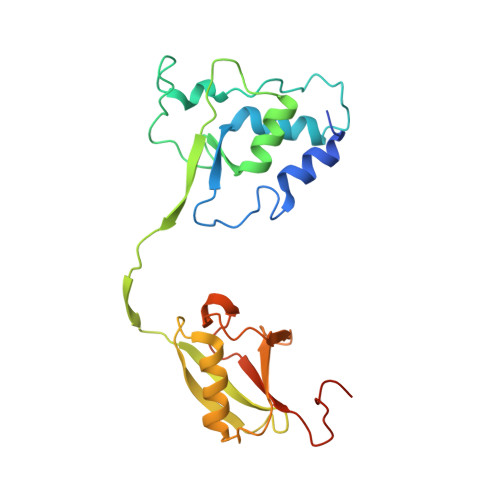Structure and Catalytic Regulatory Function of Ubiquitin Specific Protease 11 N-Terminal and Ubiquitin-like Domains.
Harper, S., Gratton, H.E., Cornaciu, I., Oberer, M., Scott, D.J., Emsley, J., Dreveny, I.(2014) Biochemistry 53: 2966-2978
- PubMed: 24724799
- DOI: https://doi.org/10.1021/bi500116x
- Primary Citation of Related Structures:
4MEL, 4MEM - PubMed Abstract:
The ubiquitin specific protease 11 (USP11) is implicated in DNA repair, viral RNA replication, and TGFβ signaling. We report the first characterization of the USP11 domain architecture and its role in regulating the enzymatic activity. USP11 consists of an N-terminal "domain present in USPs" (DUSP) and "ubiquitin-like" (UBL) domain, together referred to as DU domains, and the catalytic domain harboring a second UBL domain. Crystal structures of the DU domains show a tandem arrangement with a shortened β-hairpin at the two-domain interface and altered surface characteristics compared to the homologues USP4 and USP15. A conserved VEVY motif is a signature feature at the two-domain interface that shapes a potential protein interaction site. Small angle X-ray scattering and gel filtration experiments are consistent with the USP11DU domains and full-length USP11 being monomeric. Unexpectedly, we reveal, through kinetic assays of a series of deletion mutants, that the catalytic activity of USP11 is not regulated through intramolecular autoinhibition or activation by the N-terminal DU or UBL domains. Moreover, ubiquitin chain cleavage assays with all eight linkages reveal a preference for Lys(63)-, Lys(6)-, Lys(33)-, and Lys(11)-linked chains over Lys(27)-, Lys(29)-, and Lys(48)-linked and linear chains consistent with USP11's function in DNA repair pathways that is mediated by the protease domain. Our data support a model whereby USP11 domains outside the catalytic core domain serve as protein interaction or trafficking modules rather than a direct regulatory function of the proteolytic activity. This highlights the diversity of USPs in substrate recognition and regulation of ubiquitin deconjugation.
Organizational Affiliation:
Centre for Biomolecular Sciences, University of Nottingham, University Park Campus, Nottingham, NG7 2RD, United Kingdom.














